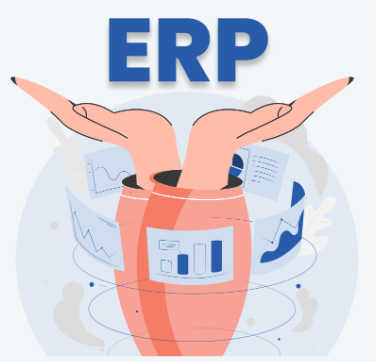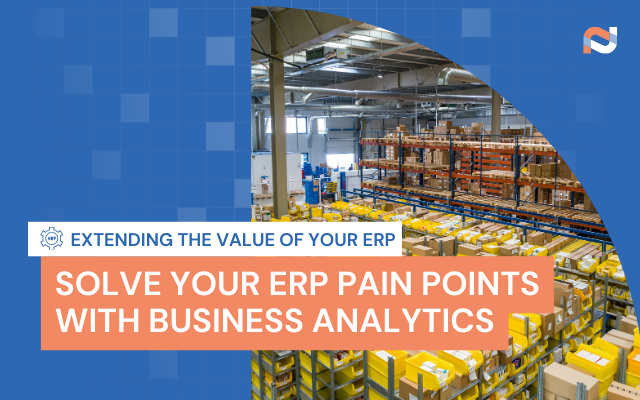ERP systems are the foundation of any successful business, but they’re not without challenges.
You will notice your ERP systems slowing down or failing to keep up as your business grows. However, the answer doesn’t lie in purchasing a new system altogether. Instead, you can often extend the value of their existing ERP via business analytics.
In this blog, we will discuss some common ERP systems’ pain points and how business analytics can help resolve them.
This article is part 1 in our series Extending the Value of your ERP:
- How to Solve Them with Business Analytics
- Extending Your ERP’s Capabilities with Third-Party Add-on Solutions
- Best of Breed Strategy vs. New ERP Investement

Understanding the Pain Points in the ERP System
ERP systems are the backbone of many organizations. This software helps centralize operations and streamline processes.
However, even with all their benefits, ERP systems come with their own set of issues.
1. Data Accessibility Issues
Many times, employees find it difficult to rapidly retrieve relevant information. Traditional ERP system reporting makes it difficult for team members to get real-time insights. This latency influences decision-making since leaders might not have a current perspective of essential metrics.
Solution: Real-time data and more flexible reporting made possible by analytics systems help to create on-demand insights. Visual dashboards and real-time measurements, for example, enable teams to make quicker, data-based choices.
2. Slow Data Processing and Reporting
Particularly in high-demand reporting seasons, outdated ERP systems can have long data processing times. Teams depending on current data for strategic planning find great annoyance in this latency.
Solution: Tools for business analytics shine in quickly handling big data volumes. Using analytics on top of your ERP system will enable quick, accurate reporting without requiring a complete ERP revamp.
3. Manual Data Entry and Errors
One main reason for mistakes in data management is manual data handling. Human error in data entering might produce discrepancies that affect general performance and reporting.
Solution: Business analytics helps to automate data collecting, therefore lessening dependency on labor-intensive procedures. Automation saves time and reduces mistakes so staff members may concentrate on more critical tasks.
4. Lack of Real-Time Visibility
Getting real-time understanding of important indicators presents difficulties for many companies. In fast-moving settings where quick information availability is essential, this disparity can especially be problematic.
Solution: Layering analytics over your ERP system gives you real-time data access, so facilitating more dynamic company reactions. Custom dashboards can provide KPIs, trends, and insights keeping everyone in the knowledge.
Integrating Business Analytics for Greater ERP System Value
So, how exactly can business analytics extend the life of your ERP? Here are some specific ways:
Enhanced Reporting and Dashboards
Most ERP systems have basic reporting, but they often lack the depth required for complex analyses. Custom reports and dashboards by business analytics solutions let firms quickly display particular insights and KPIs. Visualizing data helps you to rapidly spot trends, patterns, and outliers, therefore facilitating data understanding and application.
Automation of Routine Processes
By automating repetitive tasks, business analytics technologies help to save time spent on report generation and human data entering. Automation in inventory updates, performance monitoring, and expenditure reporting, for examples, lowers human error and accelerates standard procedures.
Advanced Forecasting
Analytics improves ERP system capability using data-driven forecasting. Forecasts of future inventory demands, sales patterns, and cash flows let companies make proactive decisions. This forecasting based on analytics helps businesses to predict to anticipate needs rather than just reacting, so offering a competitive advantage.
Real-World Example: Addressing Inventory Challenges with Business Analytics
Imagine a retail business whose reporting limits cause inventory visibility problems. They’re unable to forecast demand accurately, often leading to overstocking or stockouts.
The startup combines a business analytics platform that gathers inventory data and links it with sales forecasts instead of replacing your ERP system.
These days, they can precisely estimate future needs, track inventory in real-time, and change orders based on this information. They not only cut expenses but also raise customer satisfaction by exactly satisfying demand.
Avoiding a Costly ERP System Replacement
Changing an ERP can interfere with daily operations, be time-consuming and expensive. Business analytics add-ons, on the other hand, are less disruptive, more reasonably priced, and easier to apply. Your present ERP can be transformed by analytics, so providing many of the advantages of a new ERP without the high cost.
Conclusion: The Power of Your ERP System
Unlock the full potential of your ERP with advanced business analytics. Download our white paper, ‘Extending the Value of Your Current ERP with Business Analytics,’ to discover practical insights, detailed strategies, and expert recommendations for maximizing ERP efficiency and performance—without the cost and disruption of a new system.
